
How many times have you heard this: “I like this painting, but the size won’t work for my space”?
I’m sure I’ve heard the phrase hundreds, if not thousands, of times throughout my career in the gallery business. As much as we wish people would buy the art they love and find a space for it, there are times when space is a key consideration for the client.
I had just such a case with collectors recently. The couple was given a gift certificate to the gallery (which is a great idea I’ll touch upon in a future post) and came in mid-January to spend it. They ended up buying several pieces, but while they were in the gallery they saw one of my father’s desert landscape paintings and fell in love with it. The only problem? The space where they would place the piece was far too large for the painting’s 20″ x 60″ dimensions. They tried to think of other locations where they could place the painting, but decided they didn’t have another location for it. They decided, instead, to wait and see if something larger would come along for the space.
When I was out at their home helping install the work they had purchased, I saw the wall that was, in their minds, the perfect spot for a desert landscape. I asked if it would be alright if I took a picture of the wall so that I could show it to the artist. I snapped some quick shots with my camera phone.
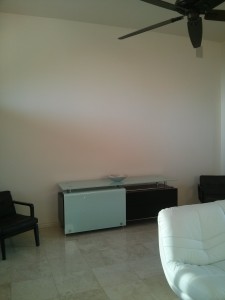
When I got back to the gallery I went to work with the photos I had taken. I was determined that one of my father’s paintings would hang on that wall, and sooner rather than later.
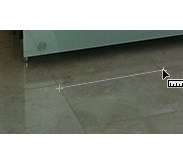 The first thing we needed to determine was what the right size would be for the space. Using Photoshop, I took the space and superimposed the smaller painting on top of the image, scaling it to several different sizes on the wall so that we could get an idea of how it would look. I created a variety of sizes and proportions to find out which looked best in the space. When I was finished, I emailed them to my father to make sure he was comfortable with all of the proposed sizes (no point in showing them an image if the artist wouldn’t be able to create the piece).
The first thing we needed to determine was what the right size would be for the space. Using Photoshop, I took the space and superimposed the smaller painting on top of the image, scaling it to several different sizes on the wall so that we could get an idea of how it would look. I created a variety of sizes and proportions to find out which looked best in the space. When I was finished, I emailed them to my father to make sure he was comfortable with all of the proposed sizes (no point in showing them an image if the artist wouldn’t be able to create the piece).
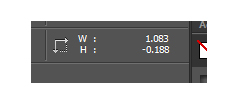 Scaling the images would have been easier if I had been wise enough to put a tape measure in the image. I didn’t. Instead I had to get a rough scale off something in the image. I was able to use the floor tiles because I could tell they were 18″ tiles. In Photoshop I measured the tiles using the measure tool, and then took that measurement and divided it into 18 to get my scale. From there it was easy to create a variety of painting sizes from the scale. They weren’t perfectly to scale, but close enough for the clients to get an idea of how the art would look. In the images below, you will notice I also added a drop shadow to the images to make the artwork feel more real.
Scaling the images would have been easier if I had been wise enough to put a tape measure in the image. I didn’t. Instead I had to get a rough scale off something in the image. I was able to use the floor tiles because I could tell they were 18″ tiles. In Photoshop I measured the tiles using the measure tool, and then took that measurement and divided it into 18 to get my scale. From there it was easy to create a variety of painting sizes from the scale. They weren’t perfectly to scale, but close enough for the clients to get an idea of how the art would look. In the images below, you will notice I also added a drop shadow to the images to make the artwork feel more real.
I emailed the images off to the clients, who were now back home in Canada (their Scottsdale home is a vacation home) and asked which size they most liked. Here is the email I sent:
This took a little longer than I anticipated, but I am sending the promised concept images for the John Horejs sunset painting for your living room. I am including four image showing different sizes. These are not to exact scale, but they are very close and should give you an idea of the possibilities. We used the image of the painting you liked in the gallery and modified it to the proportion of the example sizes. John would work with you to get just the right imagery.These are just preliminary concepts and can be refined to fit your exact need for the space.Let me know what you think!
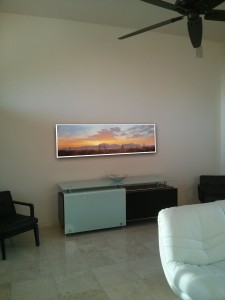



In response to the email, I received this:
Thank you Jason! I really appreciate it – we left that day on a trip to the Galapagos and have just returned … so I hadn’t looked at the images.
I will look at these with K and then provide feedback. Personally, I like images best that are wider horizontally – and not so tall (but I think the 20” may be slightly too short because of the high ceilings). Any thoughts?
Thanks!
To which I replied:
Thanks D, I agree that the 20″ size (which is the size of the one we have in the gallery now) is probably too small. The next size up, the 30″ x 72″ would create the same effect, but would fill more of the space and could look great there.
I didn’t take measurements while I was there. I wonder if I could bring the artist out for him to see the space and take exact measurements? Are you currently in town?
We are not there again until mid March – but will have a house-load of company during that visit. Perhaps we could find some time to meet then – or at our next visit during the Easter break?
Take care.
Now, a quandary. If I followed her suggestion and waited until April to meet with them again, there was a very real possibility that their interest in the piece would cool. I avoid letting too much time pass when trying to make a sale. So, I talked to my father and asked if he would go ahead and create a 30″ x 72″ sunset on spec, with the hope that it would be perfect for them. He was willing to create the piece because the subject matter and size were saleable even if this particular client didn’t end up buying it.
Once the piece was finished, I contacted the clients again asked if they might be able to see the piece while in Scottsdale in March. They said they would bring their guests along with them to see the art in the gallery. When they saw the piece in the gallery they knew they loved it but wanted to see it in the space before committing to purchase. We made arrangements to deliver the piece to their home in the few hours they would have between their guests leaving and their own departure flight.
When we first placed the piece on the wall, the wife worried that it might be too small (you’ll see that it’s actually a bit smaller on the wall than my photoshop rendition), but as she looked at it more and more she and her husband decided they loved it. I hung the piece while she wrote out the check.
These kind of sales require extra work and a little risk, but I’ve always found it to be worth the effort to go the extra mile for a client.
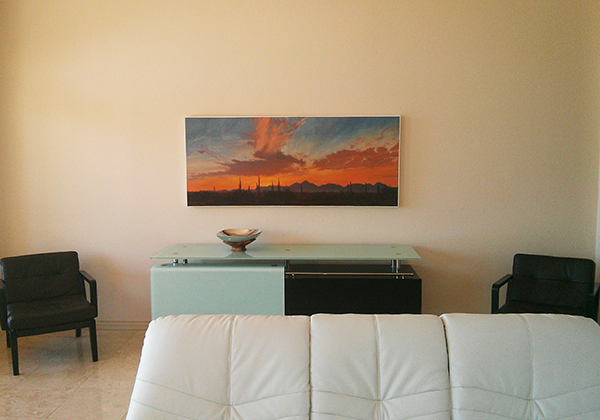
Desert Illuminated
30″ x 72″ | Oil
What Have You Done to Go the Extra Mile to Make a Sale?
Have you used Photoshop to help you make sales? What else have you done to provide extra service that has helped you make sales? Share your experiences or thought about this post in the comments below.
Please Share this Post!
If you find the posts and discussions on reddotblog.com helpful, would you please share them with your social media contacts or post a link on your blog? The wider the audience the posts reach, the better the discussion. Thank you!
Thank you for more info. Is this artwork a photograph that can be easily enlarged and cropped?
Oil paintings, so not easily reproduced, but the artist was able to create a new original very much in the same vein as the first piece.
Dear Jason,
Since you requested that your father paint another smaller, but exact, for the potential client, will the larger painting still be available and sold as “an original?”
It was available. While the new work was a similar composition, it wasn’t an exact replica by a stretch. Both are hand-created originals.
I also use a photo editor to present my work. It’s great that modern technology makes it possible to scale painting. I like how customer service and new technologies work in this article. An interesting example.
Hi Jason – you did everything exactly right – no wonder you made the sale!!! You got back to the client almost immediately, presenting them with some very real possibilities to consider, which involved them in a “buying process” – so even though they were going to be away for a while, they were “proceeding with the purchase” in their minds already by choosing the correct size for their requirements. Then you got your dad to paint a new painting to their desired size – then they did the rest by bringing their guests to the gallery with them – they would have been “letting down” their guests if they then didn’t buy it (the only risk to their friends coming to the gallery would have been if the all the friends unanimously disliked the painting – that would have been hard to overcome – but it was a very unlikely outcome, and of course didn’t happen – so the sale was made.
That said, I prefer the original painting by a huge margin, and would have purchased the original smaller work rather than the new work, even if the space really was “asking” for a larger work – but that’s just my taste. I’d rather have a “superior” work (by my taste standards) on a wall too large for it, than have a lesser painting of the right size for the wall.
But I want to also say that presenting how a painting would look on a wall is a HUGE selling tool that has turned many a browser into a purchaser.
Was the modified painting equal in quality, detail and color to the original painting? I have never used computer technology in regard to my painting. I graduated from art school in 1985 just before computers came in.
I often use Photoshop as you did Jason and have been successful in selling artwork this way. I usually ask the client to stick a couple of pieces of green painter’s tape on their wall, at the approximate width where they would like the artwork, tell me what the width is, photograph the wall and email me the jpg. Having the width helps me juxtapose the correct size for the artwork.
Personally, I love both paintings! Each has a different mood, but I think the one that was custom made fits their decor even better than the original one they fell in love with. I’m guessing your dad sensed the need to give it more contrast to match the decor. Smart!
i have found this to be a not uncommon process when dealing via designers, less often direct to clients. i as the artist draw the line at color and context changes to fit the furniture [a favourite of the designers] to those i generally decline the project. With private direct clients i will do up a couple of the adapted size works in my own manner and present them with the results. a couple more painting more or less to sell to other is no issue in my practice as i am continously paint. success rate is about 70%. sometimes the designers come back sometimes not as it is not art they focus upon but design.
Further to the theme i often adapt painting sizes to fit museum displays where i want the best effect possible. working with the director to determine the parameters. especially important where the space is crowded with other objects that cannot be moved.
I’ve not used photoshop before, but I have delivered a finished commission with a selection of 3 different style frames for the homeowners to decide on. They weren’t even sure where in the home the painting should hang and I had no idea of the style of their home. I first put it temporarily in a gold plein air style frame, which I think is a great choice for most of my oil landscapes. They liked it, and we walked around the house trying out various placements. We ended up in the master bedroom which had just been remodeled with new furniture of mid-tone woods. I changed out the frame for a hand-carved mid-tone wood frame, and that was it.
Just before I fixed the painting permanently in that frame, one of them remarked that maybe they should just see what it looked like in the third frame (weathered gray barnwood). The painting did look good, although completely different, in that frame as it brought out different colors. They ultimately chose the wood tone frame, but were astounded at the difference each frame made in the overall appearance of the painting. They were very happy, and the extra effort on my part was totally worth it.
Although I am not a Photoshop expert, I find friends who are skilled with this software tool, and they help me display my paintings. For example, I painted a landscape scene with multiple connecting canvases and using photoshop was able to remove the lines on the image where they join. These canvases were clamped together during the painting process in order to provide commonality of color across canvases, but they were framed separately. When I make a print of the entire scene, I don’t what to show the line where the canvas joins and Photoshop works great for generating clean images. Also, Photoshop can be used with cropping techniques to illustrate how my artwork will look when displaying it with different dimensions on a client’s wall. Giclee prints of your artwork can also be reproduced on canvas at reasonable cost… and this cost savings can be passed to the purchaser.
Mark
This is a little off the topic, but the ArtRoomsApp for the phone is a great tool for showing work in many different rooms or on a plain wall in various colors and also lets you put different frames on your work, which can also increase the size of the painting.
I also do this with Framed prints , when the client is not sure what it would look like on their wall , so i get them to send me a image of the wall that they were planing on putting the framed print or canvas print with the dimensions i then insert the image to scale and send it back to them ,its works every-time .I also work with them for the framing and matting to show the clients what they are getting .
Your tale about the size of the art reminds me of a patron who wanted a larger version (a triptych) of one of my original edition prints. Photoshop to the rescue!
https://www.edensart.com/blog/on1-photo-raw-2022-the-ultimate-all-in-one-photo-editor
Based on several very high recommendations from artists in my art group I tried canvy.com. It’s meant to be easier and faster than doing art room mock-ups in Photoshop, seems very easy. They suggested it works best on desktops/laptops (not iPad). They also suggested just using the “free rooms” part.
IF this had been a digital print, coming from a digital-only source, and the customer wanted a much larger version, and the dread pixelization would ruin the work, read on. I’m running older software on this Mac, and I use software from http://www.on1.com, and it’s a standalone app called “ON1 Resize 10,” and after you enter the desired final image size, it does intelligent pixel interpolation and resizes the image up, keeping it at a print-friendly 300dpi.
ON1 is still in business, and they have a standalone app, grandson of my version, called RESIZE AI. I can say I’ve taken small 6×6″ images and blown them up to 36″ square with no sweat at all.
I agree that extra work can be worthwhile and profitable. I had sold a piece to a collector off my website. She hadn’t seen it in person but texted me that she’s sure it will be fine. I took that to mean there was a slight doubt. So, I got busy painting another painting I knew she would love because it was a photo of her I had taken while hiking. At least, I had hoped so. When I went to her home to hang the first piece, she actually loved it and kept it. After we hung that piece I let her unwrap the other piece I had taken just in case she didn’t like the first piece. She was stunned when she opened it. She took it right to the wall and wondered where the best place to hang it would be as she already had three of my paintings on her “vision wall” where she visualized many more of my paintings hanging together. I suggested that she hang it above the others. She told me as soon as I put it up on the website when I got home, she would pay me. So, I put it up on the website and she paid right away. The next day she texted saying “mind. blown.” Phew! She has since bought two more pieces. So, yes, it pays to make haste to get the sale.
Thank you, Jason, for sharing your experiences. I am the owner of an art gallery in Lunenburg, Nova Scotia, Canada (Waves and Light – Art Gallery). In my gallery, I sell only my own photographs related to the ocean and nature. Most of them are printed on aluminum. I have a few large pieces, 40×50 inches, on display, but the majority of the ones in the gallery are 16×20 inches. For most clients, it is difficult to imagine what a large photo would look like in their space.
What I offer them is the option to email me a photo of their room—for example, their living room—and temporarily tape an 8.5×11-inch sheet of paper to the exact spot where they want to hang the artwork. I invite them to select a few photos from my website, and then I present some size suggestions. I use Photoshop to create mockups. By having an exact reference, I can adjust the software to make proposals that closely match what they will see in reality.
My clients come primarily from the United States and Canada, and regardless of the distance, this approach is easy to implement and has allowed me to make several sales while reassuring clients about how their space will look with their new artwork.
Daniel
I guess I’ll be the one to make this comment. Why don’t galleries sell top-quality photos? Photographers are artists too. Of course a photo or a picture of a painting can be reproduced, resized, and even stretched most any way necessary to please a customer and his/her space, and price range. A painting or an original camera shot can be printed on a variety of substrates, papers, metals, and plastics, to gain a typical framed look, or a more contemporary borderless look. I think galleries are short sighted and they need to get up to speed with what is happening, what is adaptable, and what a modern sensibility may call for. This, of course, coming for an artistic photographer, and a painter as well! (A good photograph is every bit as pleasing immediately, and over time, as a painting)